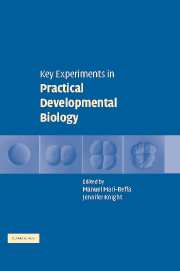Book contents
- Frontmatter
- Contents
- List of contributors
- Preface
- Introduction
- SECTION I GRAFTINGS
- SECTION II SPECIFIC CHEMICAL REAGENTS
- SECTION III BEAD IMPLANTATION
- SECTION IV NUCLEIC ACID INJECTIONS
- SECTION V GENETIC ANALYSIS
- SECTION VI CLONAL ANALYSIS
- SECTION VII IN SITU HYBRIDIZATION
- SECTION VIII TRANSGENIC ORGANISMS
- 19 Bicoid and Dorsal: Two transcriptions factor gradients which specify cell fates in the early Drosophila embryo
- 20 Significance of the temporal modulation of Hox gene expression on segment morphology
- 21 The UAS/GAL4 system for tissue-specific analysis of EGFR gene function in Drosophila melanogaster
- 22 Neurogenesis in Drosophila: A genetic approach
- 23 Role of the achaete-scute complex genes in the development of the adult peripheral nervous system of Drosophila melanogaster
- SECTION IX VERTEBRATE CLONING
- SECTION X CELL CULTURE
- SECTION XI EVO–DEVO STUDIES
- SECTION XII COMPUTATIONAL MODELLING
- Appendix 1 Abbreviations
- Appendix 2 Suppliers
- Index
- Plate Section
- References
19 - Bicoid and Dorsal: Two transcriptions factor gradients which specify cell fates in the early Drosophila embryo
Published online by Cambridge University Press: 11 August 2009
- Frontmatter
- Contents
- List of contributors
- Preface
- Introduction
- SECTION I GRAFTINGS
- SECTION II SPECIFIC CHEMICAL REAGENTS
- SECTION III BEAD IMPLANTATION
- SECTION IV NUCLEIC ACID INJECTIONS
- SECTION V GENETIC ANALYSIS
- SECTION VI CLONAL ANALYSIS
- SECTION VII IN SITU HYBRIDIZATION
- SECTION VIII TRANSGENIC ORGANISMS
- 19 Bicoid and Dorsal: Two transcriptions factor gradients which specify cell fates in the early Drosophila embryo
- 20 Significance of the temporal modulation of Hox gene expression on segment morphology
- 21 The UAS/GAL4 system for tissue-specific analysis of EGFR gene function in Drosophila melanogaster
- 22 Neurogenesis in Drosophila: A genetic approach
- 23 Role of the achaete-scute complex genes in the development of the adult peripheral nervous system of Drosophila melanogaster
- SECTION IX VERTEBRATE CLONING
- SECTION X CELL CULTURE
- SECTION XI EVO–DEVO STUDIES
- SECTION XII COMPUTATIONAL MODELLING
- Appendix 1 Abbreviations
- Appendix 2 Suppliers
- Index
- Plate Section
- References
Summary
OBJECTIVE OF THE EXPERIMENT The early Drosophila embryo is patterned by two types of morphogen gradients which are organized by maternally expressed genes. Intracellular morphogens spread within the egg cytoplasm from mRNA sources that are tightly localized to the anterior or posterior egg cortex. Extracellular morphogens spread within the extraembryonic space (perivitelline space) surrounding the embryo and depend on localized cues within the eggshell or extracellular matrix. bicoid, an intracellular morphogen, is required to specify the head and thorax of the embryo. Spätzle, an extracellular morphogen, activates the Toll receptor at the surface of the embryo, ultimately leading to a concentration gradient of the Dorsal protein, which is required to establish the dorsoventral axis of the embryo.
The following experiments explore the morphogen concept by showing how changes in concentrations of the transcription factors Bicoid and Dorsal affect the cell fates of the early embryo. Alterations of cell fates in mutant as compared to wild-type embryos will be monitored by looking at gastrulation and cuticle patterns. The observed shifts in cell fates will be correlated to the expression of zygotic genes which are targets of concentration-dependent activation and/or repression by Bicoid or Dorsal. Together, these experiments should provide an understanding of how each gradient specifies a polar sequence of stripe-like expression domains, which in turn determine the pattern of cell fates along the two major body axes.
- Type
- Chapter
- Information
- Key Experiments in Practical Developmental Biology , pp. 231 - 254Publisher: Cambridge University PressPrint publication year: 2005



